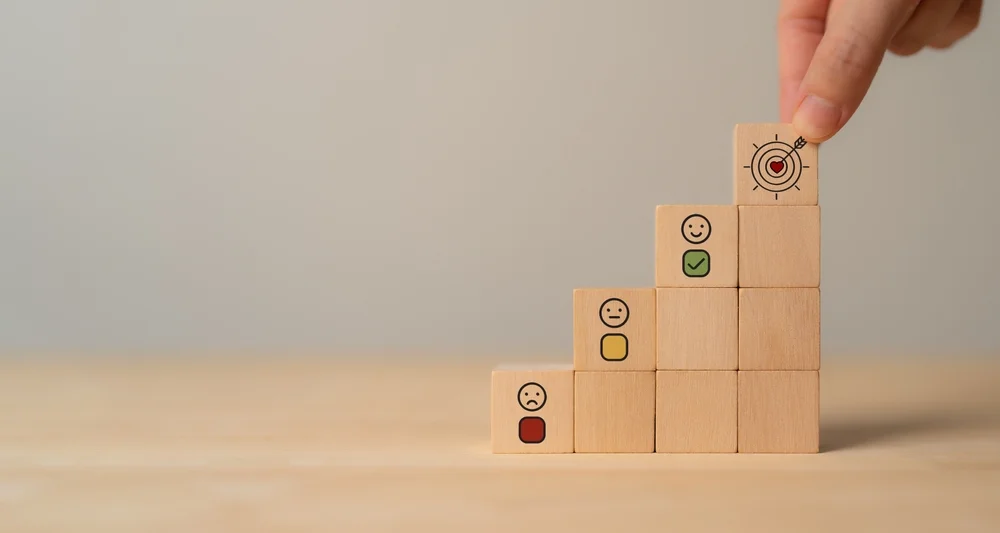Faced with advertising overload, marketing commitment has become a strategic priority for brands. The goal is no longer just to maximise the reach of campaigns, but to build lasting relationships with each customer.
Engaging audiences means capturing their attention in a relevant way, but above all encouraging active participation: comments, sharing, games, recommendations… all strong signals that reflect genuine customer engagement. Engagement is also a crucial lever for boosting key marketing KPIs (CRM enrichment, conversion, retention rates, etc.).
But what does the concept of commitment really mean? And how can it be transformed into a concrete tool for strengthening customer relationships? This guide offers a comprehensive breakdown of commitment in marketing, with best practices for activating it effectively and key indicators for measuring it.
SUMMARY
- What is marketing commitment: definition?
- The different types of marketing commitment (and associated KPIs)
- Why companies need to engage their customers: the marketing benefits
- What levers should be activated at each stage of the customer journey to ensure long-term engagement?
- 5 steps to implementing an effective marketing commitment strategy
What is marketing commitment: definition?
Marketing commitment refers to all voluntary interactions that a consumer has with a brand, across different channels (digital and physical) and over time.
According to research firm Forrester, it is ‘the creation of deep and meaningful relationships with customers through personalised and relevant interactions’.
1. How can you recognise an engaged customer? Signs to look out for
Unlike so-called vanity metrics (impressions, likes, unqualified traffic), customer engagement manifests itself through concrete behaviours that can be measured across different channels.
Here are the main signs to watch out for:
- High recurrence rate: regular purchases, frequent visits to the website or app.
- Active interactions: clicks on emails, participation in marketing games, responses to surveys.
- Spontaneous contribution: customer reviews, comments, shares on social media.
- Recommendation: participation in mentoring programmes or visible word-of-mouth advertising.
- Community membership: registration for a loyalty programme, presence on forums or user groups.
- Alignment of values: commitment to brand campaigns with a strong social or environmental dimension.
Not to mention that all of these signals feed into even more strategic KPIs for brands, namely multiple conversion KPIs.
The different types of marketing commitment (and associated KPIs)
Marketing commitment is not limited to a single interaction. It encompasses several dimensions, each reflecting a specific and measurable level of customer involvement.
1. Contextual commitment
It relies on the ability to interact with consumers at the right time, through the right channel and with the right message. This commitment is based on behavioural data (browsing, purchase history, location) to offer tailor-made experiences.
Example: sending a personalised push notification to a store, triggered by the customer’s presence nearby, with an offer related to their recent purchases.
Related KPIs: click-through rate or conversion rate on contextual messages.
2. The commitment of convenience
It stems from ease of interaction with the brand. The smoother, faster and more frictionless the customer journey, the stronger the engagement. This type of customer relationship is based on automation, service availability and user-friendly interfaces.
Example: Amazon Dash Buttons, which allow users to order everyday products instantly.
Related KPIs: repurchase rate, retention rate or reactivation rate.
3. Emotional commitment
This is the deepest and most lasting form of commitment. It is based on attachment to the brand universe, its values, or the customer experience. This commitment is built over time and strongly influences loyalty.
Example: Apple, which combines design, innovation and storytelling to create a strong emotional connection with its customers.
Related KPIs: Net Promoter Score (NPS), satisfaction rate, recommendation rate.
4. Social commitment
Example: Patagonia, whose customers widely share the company’s ethical and environmental actions on social media.
Related KPI: number of shares, social mentions, engagement rate on posts, or volume of UGC (user-generated content).
Why companies need to engage their customers: the marketing benefits
Marketing commitment has become a strategic lever for stimulating growth and strengthening customer loyalty. Beyond one-off interactions, it is about building a lasting and differentiating relationship with each user.
Here are the main benefits that come directly from strong customer engagement:
1. Increased retention and loyalty
A committed customer is a customer who remains loyal to the brand. According to a Gallup study, fully committed customers generate 23% more revenue than average.
2. Enhanced customer satisfaction
Regular, personalised interaction that is perceived as useful increases perceived satisfaction. According to Salesforce, 80% of consumers believe that the experience offered by a brand is as important as its products.
3. Enhanced brand reputation
An engaged customer is more likely to share a positive experience. On social media, this viral effect allows you to reach new audiences. Engagement thus generates increased word-of-mouth and UGC (user-generated content), which boosts brand visibility and credibility.
4. A decisive competitive advantage
What levers should be activated at each stage of the customer journey to ensure long-term engagement?
Marketing commitment is an evolving dynamic that is built up throughout the customer journey. A brand will not engage a cold prospect in the same way as a loyal customer. Identifying the right levers according to the maturity level of the audience enables relevant and personalised interactions to be activated.
Engage from the prospecting stage
1. Inbound marketing
Inbound marketing consists of naturally attracting the attention of a target audience through relevant, useful and engaging content. At the prospecting stage, it generates a first, non-intrusive interaction with the brand, based on the audience’s interests. By sharing inspiring or educational content, the brand gradually builds a relationship of trust.
3 tips for turning inbound marketing into a lever for engagement:
- Create high-value content (tutorials, studies, practical guides) that addresses specific issues faced by the target audience.
- Optimise formats for interaction: integrate quizzes, surveys or fun formats (such as Swiper).
- Set up personalised nurturing workflows: offer additional content based on browsing behaviour to maintain attention and encourage the next action.
2. Playable marketing
Contests, for example, are a powerful tool for capturing the attention of new audiences and generating immediate engagement around an attractive prize or unique experience. During the prospecting stage, this type of engaging format also promotes virality, the collection of qualified data and the creation of an initial emotional connection with the brand. If well targeted, it can also be used to pre-qualify prospects according to their interests.
Examples: The Kiabi brand launched an international casting call in five countries to recruit new leads. The mechanism: a contest giving participants the chance to win a rewarding experience—becoming the brand’s spokesperson for a photo shoot. Thanks to targeted ad campaigns, the brand was able to precisely target its various audiences (young professionals, families, seniors), optimising the performance and quality of entries.
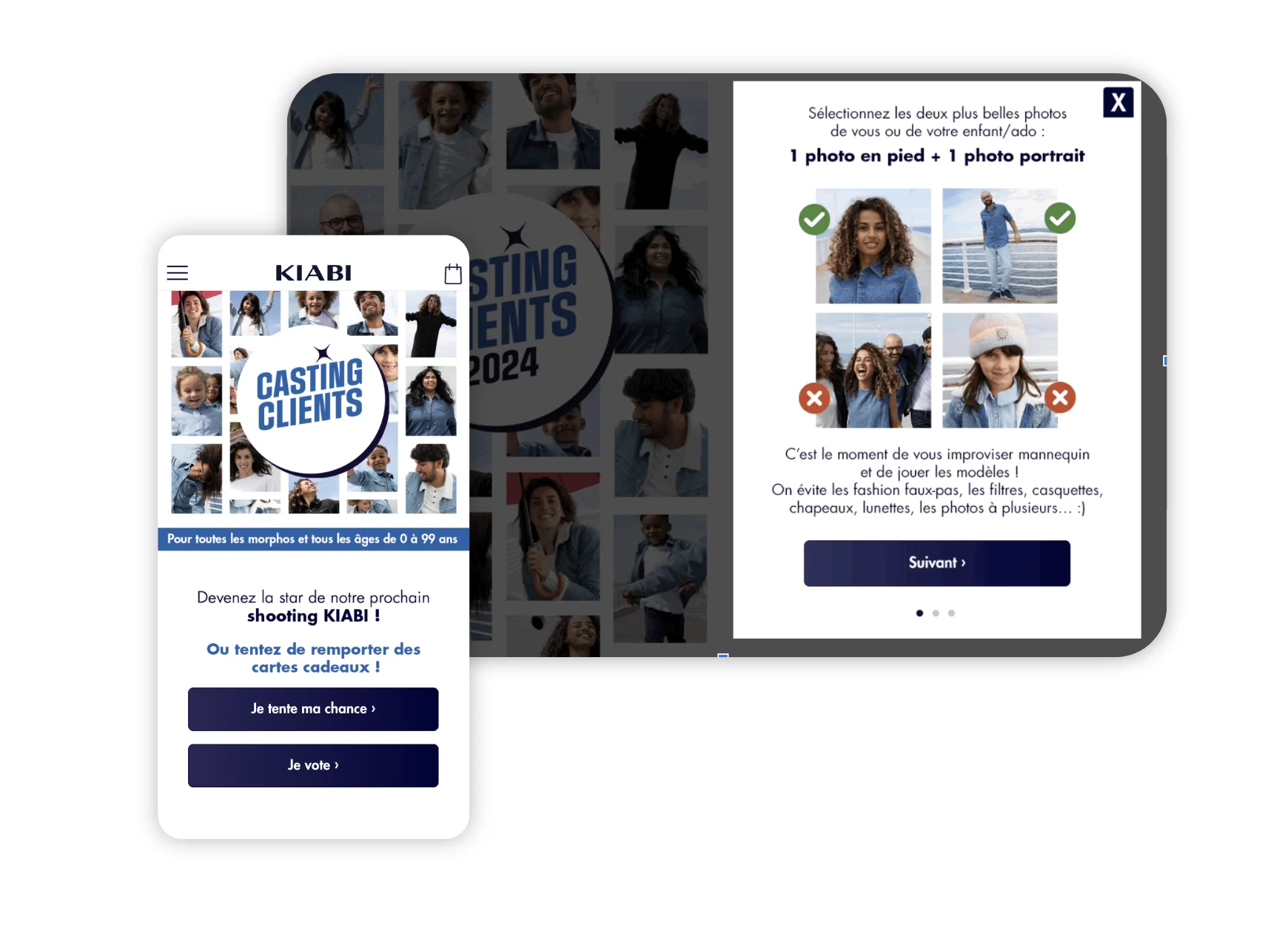
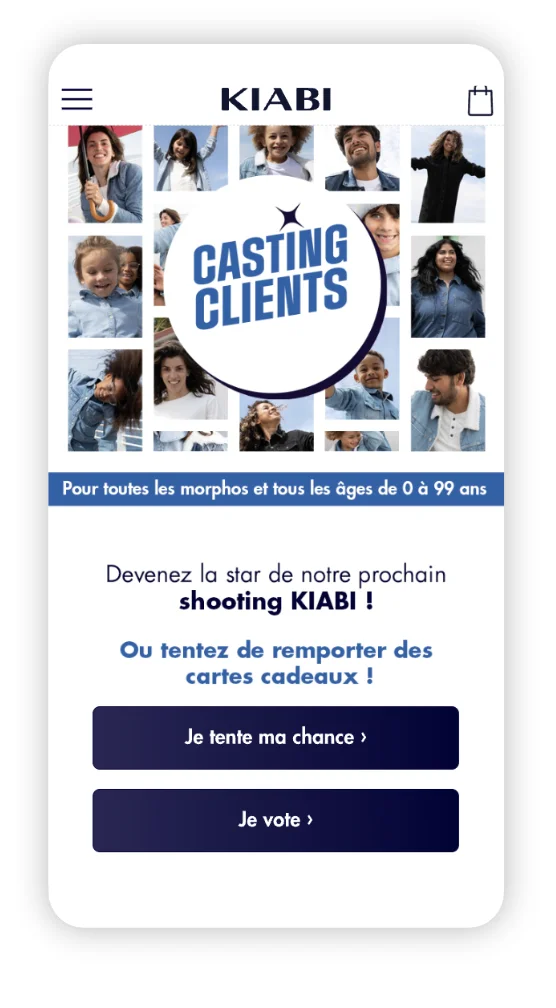
To celebrate its 35th anniversary, Cuisines Références launched a Winning Calendar with the aim of boosting its brand awareness and generating new qualified leads. The result: over 500 prospects ready to be contacted and 5,000 clicks to the offer page.
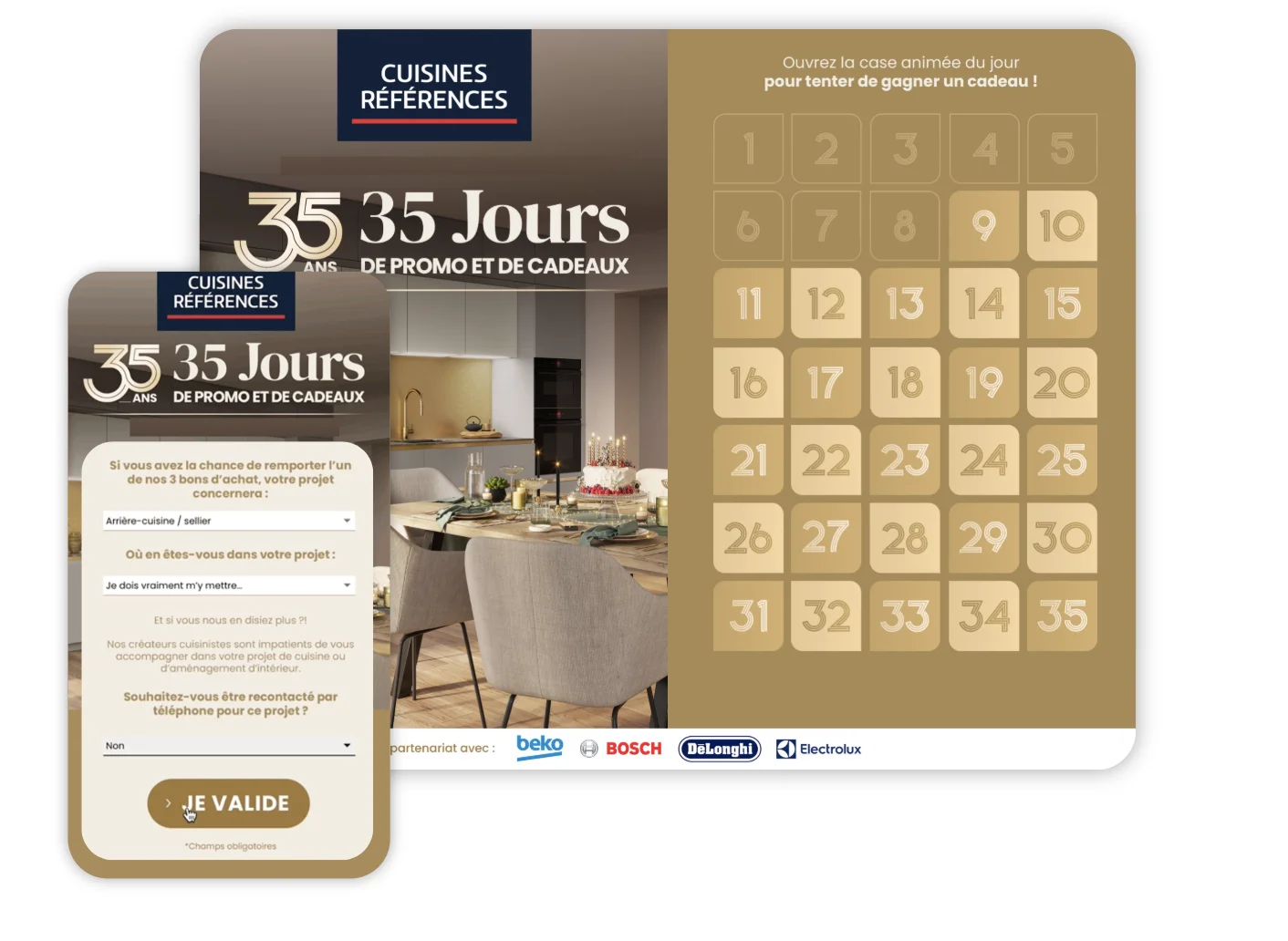
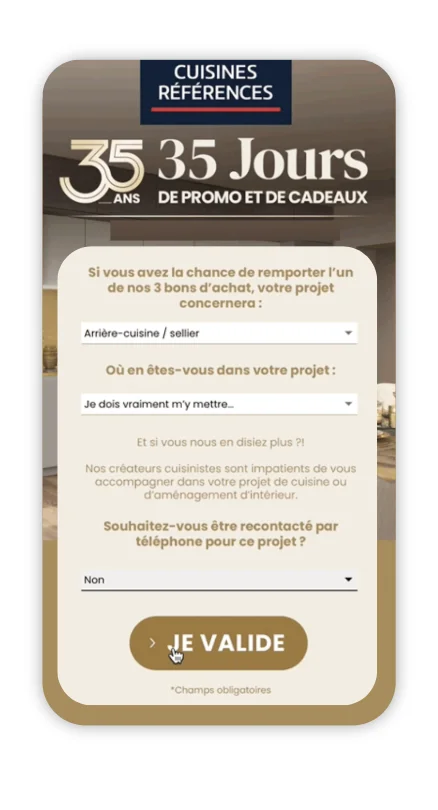
3. Content marketing
Content marketing allows you to capture the interest of new audiences by creating value-added content that is relevant and targeted to their expectations. It naturally attracts visitors to the brand’s channels (SEO, social media, newsletters) while strengthening its credibility and status as an expert.
3 tips for turning content marketing into a lever for engagement:
- Design useful and actionable content: guides, infographics, webinars or blog articles that meet a real need of the target audience.
- Optimise search engine optimisation (SEO): use the right keywords to appear in relevant searches by prospects in the discovery phase.
- Encourage conversion through tailored calls to action: offer a free downloadable resource, a newsletter subscription or a free trial to kickstart the relationship smoothly.
From commitment to conversion
At this key stage of the journey, the aim is to turn interest into action. The mechanisms used must reduce friction and stimulate decision-making while reinforcing the perceived value of the offer.
4. Instant wins
Instant wins, for example, are fun, simple and quick devices that encourage action by relying on the mechanics of immediate reward. This format of playable marketing stimulates action through instant gratification. It plays on curiosity and the desire to win, while encouraging interaction with the offer in a transactional way.
Sephora offered a 100% winning Skin Care game to boost its web traffic, generate sales via promo codes, and enrich its database with qualified opt-in profiles.
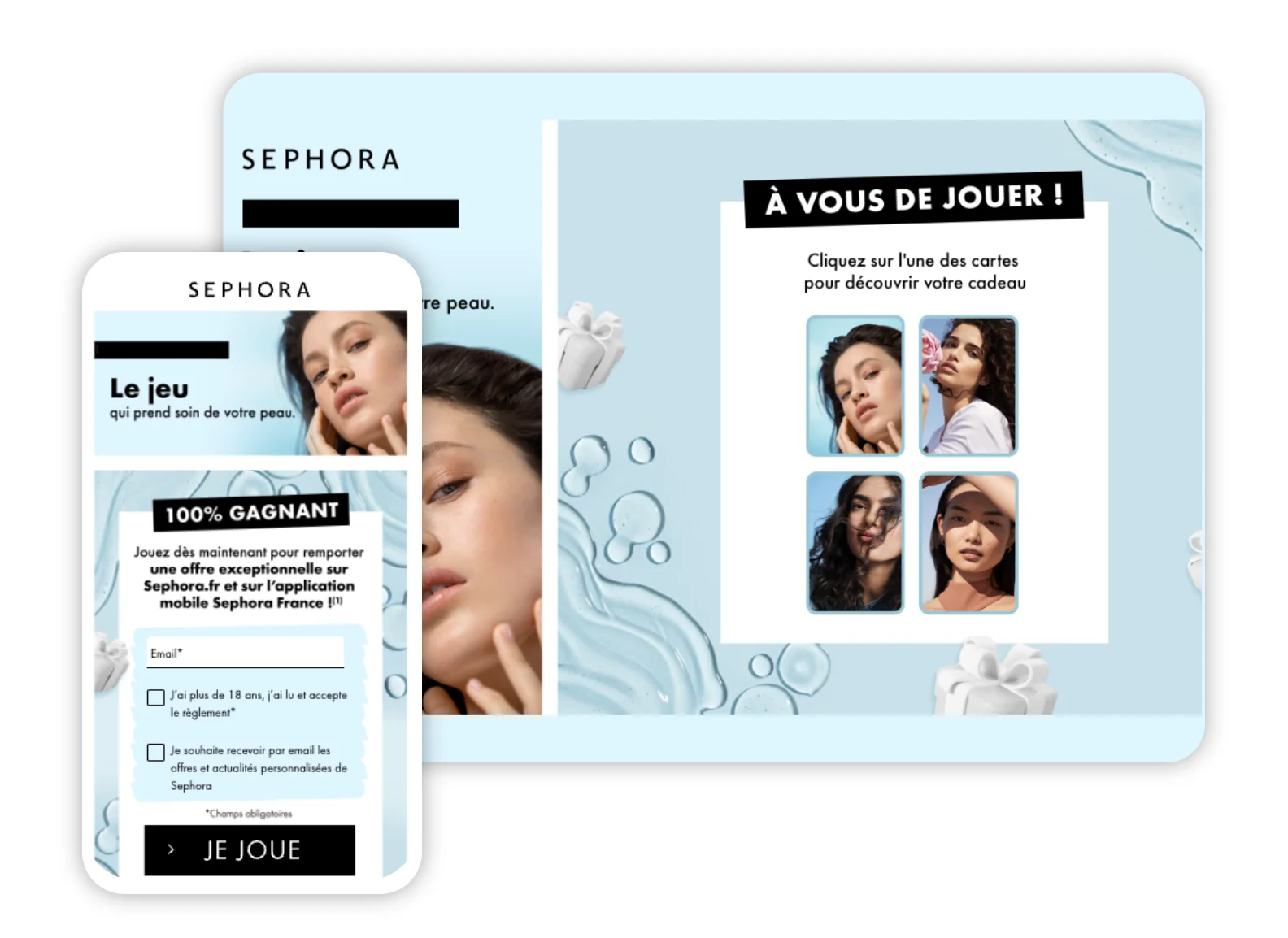
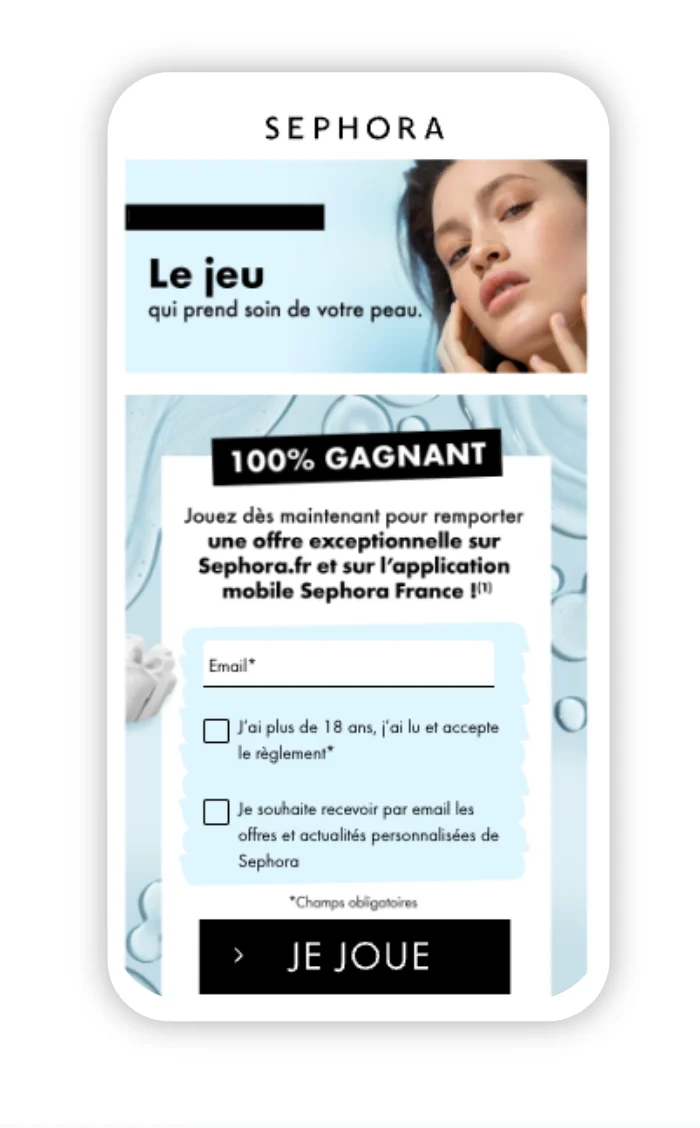
For Mother’s Day, Sephora also launched a 100% winning Piñata game. With no forms to fill out, the simplified process allowed participants to instantly reveal their prize, streamlining the conversion funnel. This campaign boosted traffic to the website and app and increased revenue by promoting flagship products through the distribution of promo codes.
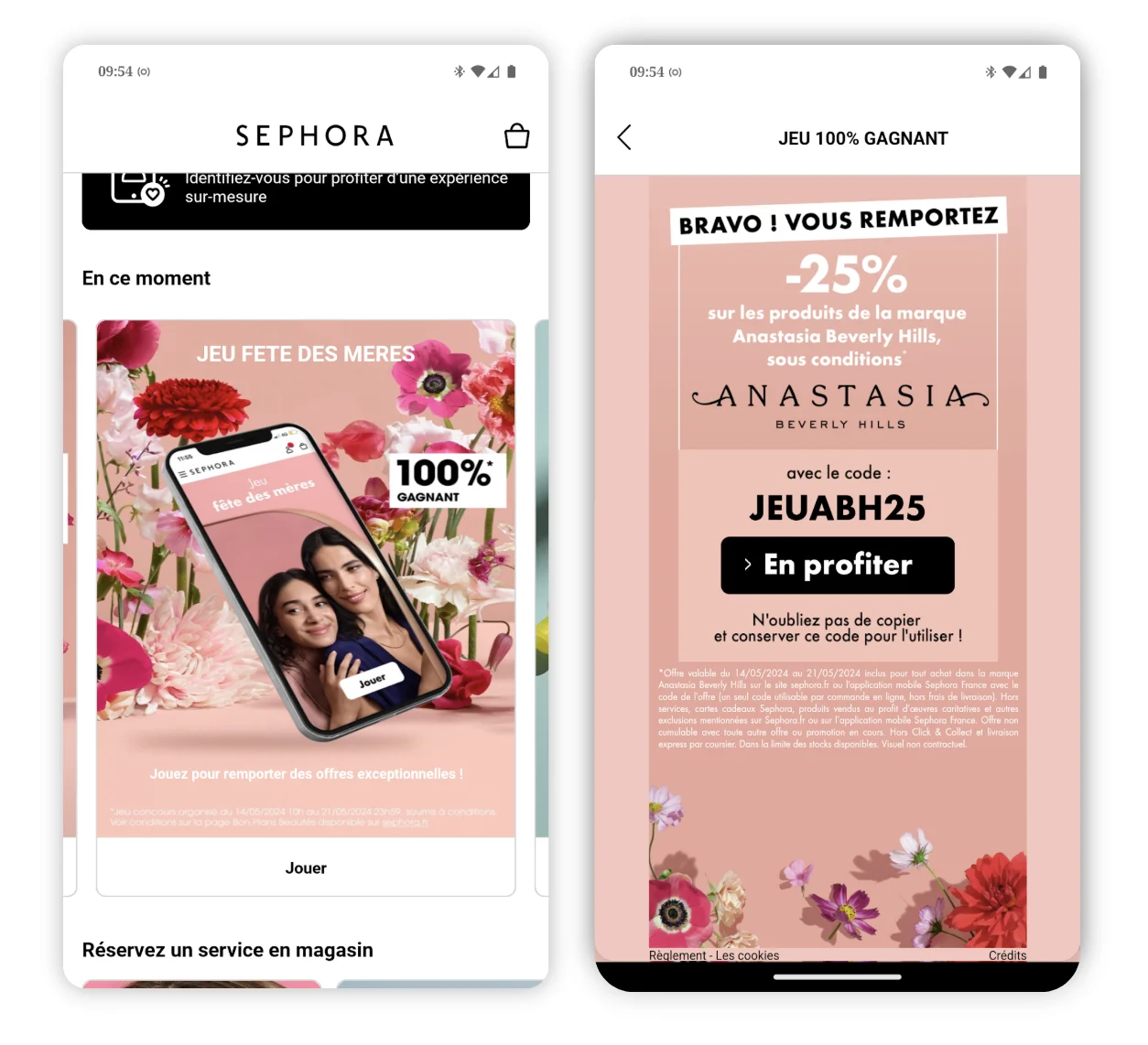
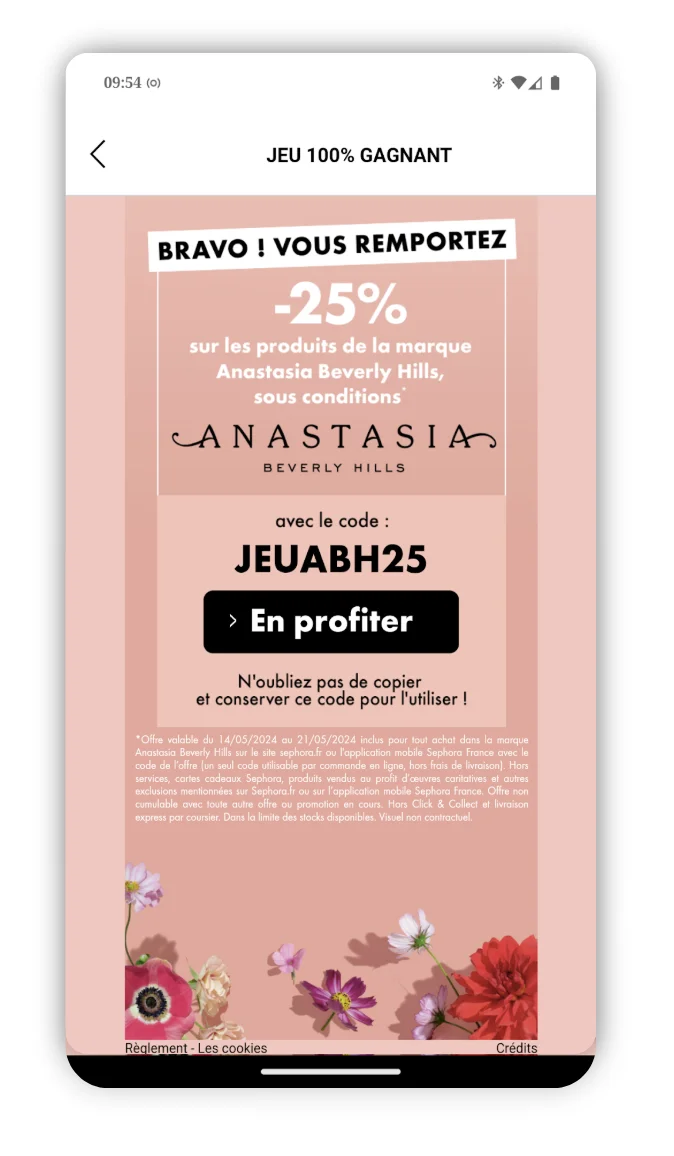
5. Playable Ads
Playable Ads are interactive advertising formats that allow users to experience a mini-game directly within a display ad. They capture attention in a fun way, encourage interaction and reduce resistance to purchasing. By offering a short and engaging experience, they facilitate product discovery while encouraging immediate action, often through an exclusive offer.
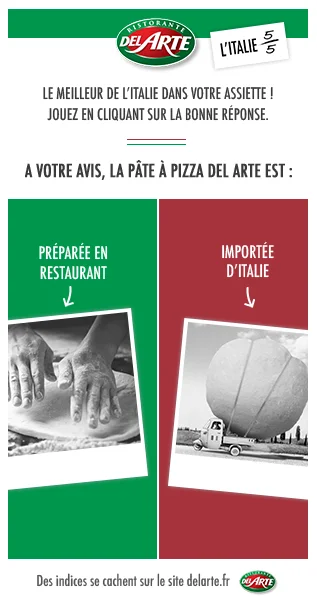
6. Influencer marketing
Influencer marketing involves collaborating with content creators or well-known personalities to promote a brand to their engaged communities. At the conversion stage, influencers bring authentic credibility and humanise the brand, which can transform a hesitant prospect into a convinced customer. Their recommendation acts as a powerful driver of engagement and conversion.
3 tips for successful influencer marketing:
- Select influencers aligned with the brand’s values and target audience to ensure message consistency.
- Promote authentic and creative content that encourages interaction rather than simple advertising posts.
- Measure impact using precise KPIs (traffic, conversions, engagement) to adjust the campaign in real time.
Commitment to customer loyalty
At this stage, the focus is on maintaining a lasting relationship with the customer, strengthening their loyalty to the brand and encouraging repeat purchases. It is about nurturing trust and offering a personalised experience to turn satisfied customers into true brand ambassadors.
7. Email marketing
Email marketing provides a direct and personalised channel for maintaining customer relationships, sharing exclusive offers and advice, and sending invitations to events. This regular contact stimulates engagement and loyalty in the long term.
3 tips for optimising email marketing with customer loyalty in mind:
- Segment subscriber lists to send messages tailored to customer profiles and behaviours.
- Customise content and subject lines to maximise open and engagement rates.
- Include clear calls to action and exclusive offers to encourage conversion and loyalty.
8. The loyalty program
The loyalty program is a key lever for transforming one-off engagement into lasting relationships. By offering rewards, exclusive benefits or unique experiences, it strengthens the emotional bond between the brand and its customers.
Example: Quick launched an innovative marketing campaign on its mobile app, featuring star player Tony Parker and gamification elements (via an Outrun mechanic). This Playable App format enabled Quick to recruit new members to its loyalty programme.
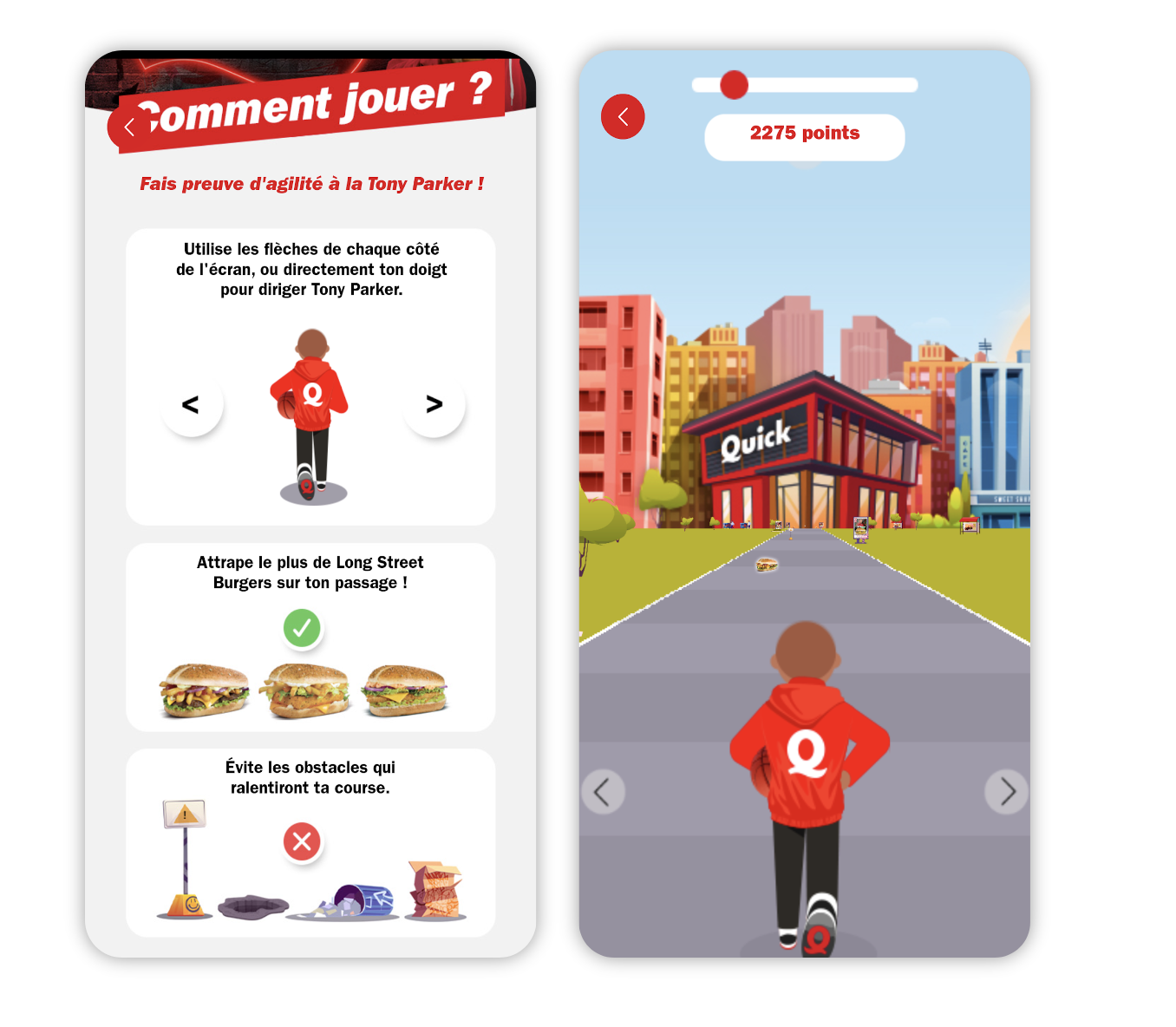
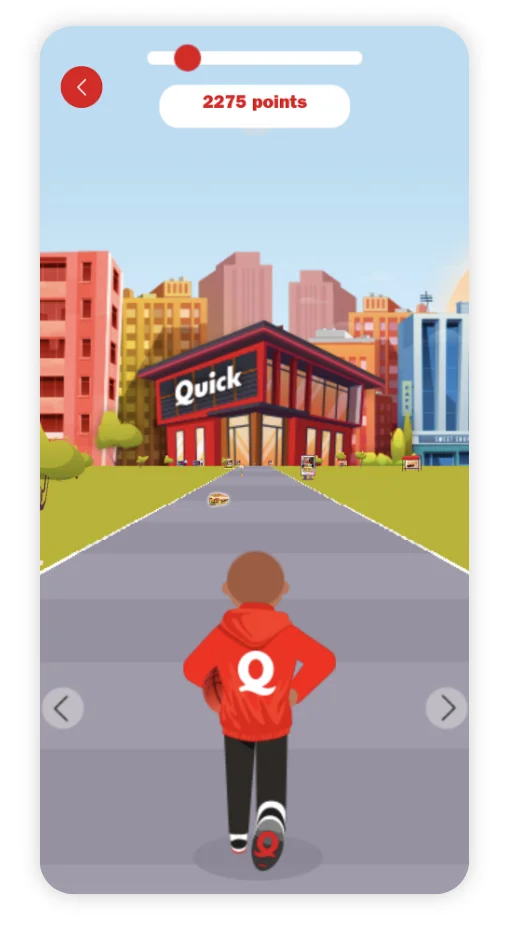
5 steps to implementing an effective marketing commitment strategy
Developing an effective marketing commitment strategy requires several key steps. This process ensures that your action plan is consistent and aligned with your company’s overall objectives. At the same time, it maximises your company’s ability to engage its audiences over the long term.
1. Define clear objectives for your engagement strategy
Engagement campaigns are more effective when they are structured around specific objectives that are aligned with the company’s overall strategy. These objectives must be translated into concrete key performance indicators (KPIs). For example, if the challenge is to increase customer lifetime value (CLV), the objective may focus on loyalty or retention. This clarity makes it easier to measure the real impact of the engagement campaign and guides the design of future actions.
2. Identify and understand your target audience
Precise targeting and a good understanding of the audience (through the creation of personas, for example) are essential for delivering relevant content. This involves analysing the needs, preferences and behaviours of your audience using data from CRM, customer surveys and behavioural analysis. This data-driven approach allows you to effectively segment your audience and tailor your message to each profile to maximise engagement.
3. Write personalised, impactful content
Personalisation is at the heart of engagement marketing. Content that resonates with customers’ expectations captures their attention and enhances their experience. This can range from simple email personalisation to the creation of dynamic funnels that adapt to different user segments. Personalising the content you deliver ensures that your message is relevant and has a greater impact on each prospect or customer.
4. Optimise your distribution strategy by targeting the right channels
To maximise the impact of engagement campaigns, it is crucial to choose channels where the audience is already present and active. Here is a checklist for selecting the right distribution tools, depending on the target audience and objectives:
- Social media:
- LinkedIn for a B2B or professional audience
- TikTok to reach a young and mobile target audience
- Instagram to showcase visual and lifestyle products
- Email marketing: ideal for building customer loyalty or re-engaging an existing audience
- Programmatic advertising: effectively retarget non-converting visitors with personalised content
- Mobile apps: to strengthen engagement within an already captive community
- Dedicated website or landing page: essential for centralising the experience and capturing customer data
This omnichannel approach, designed based on actual user behaviour, enables a consistent experience to be delivered at every touchpoint.
5. Measure and improve customer engagement
Monitoring strategic KPIs such as interaction rate, conversion rate, and retention rate allows you to evaluate the performance of your customer engagement strategy. Regular analysis of results and feedback from people who interact with the brand provide levers for continuous improvement.
Conclusion
Marketing commitment is key to turning simple contacts into loyal customers and even brand ambassadors. At every stage of the journey, adopting the right strategies helps create rich and lasting interactions. To effectively boost this commitment, gamification is one of the most powerful tools at your disposal. Discover how Adictiz solutions can energise your marketing by making every experience more fun, personalised and impactful. With our gamified formats, you will take your customer relationship to the next level.


